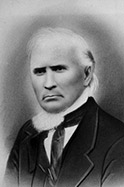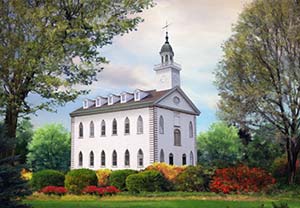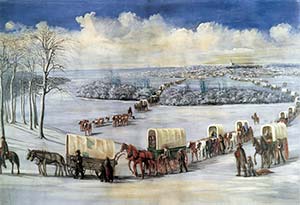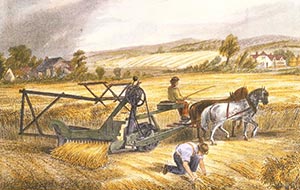Charles Bird, Sr. ~ Index

My great, great grandfather, Charles Bird, was the second child and second son of Benjamin Freeman and Marabah (Milly) Reeves Bird. They had a family of nine sons and three daughters. Charles Bird was born 19 September 1803 in Roxbury Township, Morris County, New Jersey. The Bird Family moved to New York State sometime before the 1830 census was taken for Benjamin F. Bird and others of his family are listed in Southport, Tioga County, New York at that time. In the meantime Charles Bird had married Mary Ann Kennedy, daughter of John Kennedy (called Dr.) and Elizabeth Churchill. They were married 22 March 1826 in Covington, Tioga County Pennsylvania. Mary Ann Kennedy was born 7 December 1807 at Great Barrington, Berkshire, Massachusetts.
In 1838 we find Charles Bird, his father and other members of the family in Kirtland, Ohio. In the spring of 1838 there was a great deal of turmoil among the Saints in Kirtland. Enemies to the church, including some apostates, were threatening members lives and property. Joseph Smith and Sidney Rigdon had to flee with their families in the middle of the night to escape the mob. Shortly after this, the Seventies Quorum in Kirtland began making plans for a group of Saints to travel as one large caravan to Missouri. They drew up a constitution or a set of rules that every head of family participating in the journey had to sign. Charles Bird with seven members listed as his family was one of the signers of the document.
Upon their, departure from Kirtland on 6 July 1838, this mile-long caravan consisted of 529 men, women and children with 97 horses, 22 oxen, 69 cows, 59 wagons and 33 tents. There were several families that shared each tent with one man appointed to oversee each tent. A daily log of the Kirtland Camp is found in Joseph Smith's History of the Church and B.H. Roberts Documentary History of the Church. The Camp arrived at Adam-Ondi-Ahman on 2 October 1838.

At this time, persecutions in Davies County were very severe and the members of the camp remained at Adam-Ondi-Ahman for about two months, Governor Bogg's exterminating order was actually given on 27 October 1838, just shortly after this group arrived in Missouri, It is likely that Charles Bird and his family lived either in a tent or a wagon for the whole time that he and his family were in Missouri.
The Prophet at this time was incarcerated in Liberty Jail, therefore responsibility for the Saints care fell upon the Quorum of the Twelve Apostles. Brigham Young, being President of the Quorum of the Twelve was very concerned that everyone would cooperate in moving from Missouri to Illinois. He was especially concerned with the widows and their families. He drew up a covenant that those that were willing could sign, pledging their cooperation in helping each other move from Missouri. Charles Bird and Benjamin F. Bird were both signers of this covenant.
Charles Bird was chosen as one of a seven-man committee with the responsibility of removing the poor from the state of Missouri. Charles was also appointed to go down towards the Mississippi River and establish deposits of corn for the brethren on the road and make contracts for ferriage, etc. He was assigned to visit several parts of Caldwell County to ascertain the number of families there that would need to be assisted and on 17 March 1839 he and Daniel V. Rogers of Quincy, Illinois went to Jackson County with the power of attorney, which Charles obtained at Liberty in February, to attempt to sell the properties there.
Finally the Bird Family settled in Nauvoo, Illinois. Charles Bird had been ordained to the First Quorum of Seventies by Joseph Young in January 1839. When the Quorums of Seventies were organized in Nauvoo, Charles Bird was chosen one of the seven presidents of the 13th Quorum of Seventies which was organized on 21 November 1844. He and his wife, Mary Ann were sealed together on 29 January 1846.
Charles became a close associate of the Prophet Joseph Smith as he became one of his bodyguards. The men took turns on guard, and when it was Charles' turn to go on guard, the man he was to replace would ride to the top of the hill close to the Bird home and take off his hat and wave it. That was Charles signal to take over and he would wave back.
There are two stories told regarding Charles duty on the day the Prophet was killed. They are as follows: The day the Prophet was killed was the day for Charles to go on guard. The man preceding him rode to the top of the hill, got off his horse and knelt on the ground with his head bowed. Charles knew that the Prophet was dead, 27 June 1844.
Charles had gone off duty the night before the Prophet and his brother, Hyrum were murdered. He had gone to his farm for fresh clothing and supplies for the Prophet, his brother, Hyrum, John Taylor and the others. His wagon was loaded for the return trip to town and he was having an early breakfast when he heard hoof-beats of a horse in the distance. He told his wife to look out the window and tell him what color the horse was that would be on top of the hill between their farm and the city of Nauvoo. She looked and told him that it was a white horse; he dropped his head in his hands and sobbed, "They have killed the Prophet." It had been previously arranged, by the bodyguards that if extra help was needed to protect the Prophet, some one would ride to the top of the hill on a black horse, but if the, Prophet had been killed they would be on a white horse. Charles left his loaded wagon at home and rode horseback to Nauvoo where he witnessed many of the trials and hardships of the Saints at that time.
Nellie Tracy Clark says in her history of Charles Bird, My grandmother, Mary Jane Bird Tracy said that he used to hold her on his knee when she was a little girl and tell her about the things that took place in Nauvoo, of the Prophet and his wife, of the many fine things that Emma did for the people. He told of the dedication of the Temple and how the spirit of the Lord was there in such abundance that you could actually feel it and of the bright light that shone around the Temple and it sounded as though Angels of the Lord were there singing.

He told her of the time when Brigham Young was chosen to lead the church; how, when he talked to the people on that occasion he seemed to be talking in the voice of the Prophet Joseph Smith and for a short time he even looked like the Prophet.
The Bird family suffered many hardships with the other Mormon Saints;
Charles' home was burned several times and he would then have to start over. When the Saints were finally forced to leave Nauvoo, Charles wagon was first to cross the ice of the Mississippi River on 5 February 1846. President Brigham Young had him cross to see if the ice would hold the wagon up. He was ready to come west with the first company of Saints, but President Brigham Young requested him to remain and help the Saints sell their property, and get teams and wagons to emigrate to Utah.
In 1850 Charles Bird and his family with his father, Benjamin Freeman Bird, and three brothers, James, Richard and William, came to Utah. They left the Missouri River 3 June 1850 as part of the Milo Andrus Company which consisted of 206 persons and 51 wagons. They arrived in the Salt Lake Valley on the 10 October 1850. This large Bird Family settled first in Springville, Utah. Charles and his family were soon sent to St. George for a short while, but he soon returned to live in Cottonwood in Salt Lake County. Charles served as a counselor to Bishop Smoot in the Cottonwood Ward for four years while they lived there. Charles entered into the practice of polygamy on 3 February 1853 when he and an English girl, Sarah Ann Dunsdon, were married by Brigham Young. Sarah Ann Dunsdon was born 8 May 1833 at Steeple Ashton, Wiltshire, England to James Dunsdon and Mary Ann Rose.
In the spring of 1859, Charles and his family moved to Cache Valley and settled in Mendon; he was among the first families to settle there. They lived in a fort in their wagons until they could build dugouts and log houses. Charles' and Sarah Ann's daughter, Mary Jane, was the first white child to be born there. The first apple trees in Mendon were started by Charles Bird, Senior, while people were living in the old Fort between the years of 1859 and 1863. Charles Bird started a seedbed, the apples being purchased in Great Salt Lake City. The following year the young trees were planted in permanent places, his cabin being in a position where he did not have to move when the people moved out of the Fort.
(Our Pioneer Hertiage Vol. 19)
Charles was always ready to help the Saints, his home was always open to them until they could get a place to live. His wagon and team, with his son Bradford, as driver, crossed the plains five times with immigrants. The following is taken from his daughter's (Adelia) diary: At the time the places of Cache Valley were named and bishops elected, the meeting was held in our house, it being the largest house in town. It was a log mansion with dirt roof and floor. Andrew P. Shumway was chosen bishop. President of the Stake, Peter Maughan, and Orson Hyde attended the meeting. Mendon was named in remembrance of Mendon City, New York, a place where President Brigham Young once lived.
The following is taken from an early "Pioneer Record Book;" In a meeting held in the early part of winter of 1859 at Father Charles Bird's house, with apostles Orson Hyde and Ezra T. Benson present, the ward was organized. And it was asked by what name shall this settlement be known? It was at the time known as
Charles Bird helped start the first woolen mills in Utah. He was a clerk and weaver by trade and he was the first director and clerk in the first store in Mendon. In "Heart Throbs of the West" is written: North Settlement.
It was proposed that Elder Benson should name it. Well then he said, I will call it Mendon after the town in which I was born, Mendon, Massachusetts.
And it was satisfactory with all present.In Mendon, the first merchandise was sold by Charles Bird in his residence. Mormon Bird remembered that a pound of tea then sold for $6.25. A bushel of wheat sometimes sold for $5.00.
At times peddlers brought some articles to town such as shoes, groceries, dry goods, etc. to sell or trade. About 1867 Charles Robbins of Logan sold some goods in the rock house of Charles Shumway.
The Mendon Co-op Store was started in the spring of 1869 under the direction of Bishop Andrew P. Shumway in the rock house belonging to Charles Bird. James G. Willie served as clerk and salesman. When Bishop Shumway went to England on a mission, the management of the store fell to his successor, Bishop Henry Hughes. From the house of Charles Bird the store was moved to the log house of Albert M. Baker.
Charles held the office of city mayor from 1872 until 1876, he was a member of the school board and he and his sons owned and operated a farm also. The following is taken from "Heart Throbs of the West;" The early settlers of Mendon, like other pioneers, were confronted with a difficult problem to harvest and thresh their first crops of grain. With the united efforts of both men and women working in the fields together it was finally accomplished.

Messrs, Bird and Shumway had a reaper in about the year 1863 which was considered a marvel and a wonder. It required a driver, a man to rake the swath off the platform and several more followed after to bind the sheaves: About the same year, Andersen, Bird and Findley procured a thresher known as the Chaff-Piler. It would thresh the grain from the head, after which a hand-powered fanning mill followed up to separate the wheat from the chaff. This machine was driven by a two horse tread power. The fanning mill would be several weeks behind the Chaff-Piler and sometimes it became necessary to run night shifts. The threshing was accomplished by this crude method until 1865 when the Hills from Cottonwood brought a Buffo-Pitts thresher and separator combined.
The Birds also operated a Case Machine in about the year 1865, which required a speed-jack which was driven from the power and thence a belt from the jack to a cylinder. The Bankheads from Wellsville also brought a machine to Mendon to assist with threshing.
The wire-binder was introduced by the Bird brothers. So marvelous was this machine that a demonstration of it was staged down below town on the Bird farm. The townspeople turned out to see it, women and children included. However, this machine became objectionable owing to the fact that bits of wire would lodge in the cattle's stomachs and cause premature death. This machinery took care of the harvest until 1870 when the Co-op bought an improved thresher built by Nicholas and Sheppard Company at Battle Creek, Michigan. This machine and another Buffo-Pitts purchased by the Birds and Hills did the threshing for years. Among those who followed the threshers year after year was Lewis Bird, son of Charles.
Charles died at the age of 81 on 29 September 1884 at Mendon and was buried in the Mendon City Cemetery. He had all his own teeth and not one was decayed, but badly worn down at the time of his death. He was a true Latter-day Saint, a good father and left a great posterity among which are Bishops, High Councilmen, Stake Presidents, Patriarchs and many civic minded citizens. His life was indeed a life of service.
Charles died in his beloved Mendon 29 September 1884 and was buried in Mendon Cemetery on 3 October 1884. This is a lovely spot sacred and silent overlooking the entire Cache Valley. He leaves a great posterity through out Utah, Arizona and Idaho and we are proud of him.
Life Sketch
Charles Bird son of Benjamin Freeman and Marabe (Marabah) Reeves Bird, was born at Flanders, Morris County, New Jersey, 19 September 1803. He was married to Mary Ann Kennedy on 22 March 1826. They lived for a while at Elmire, Tompkins County, New Jersey, then moved to Hector. They lived there until 1838 and then moved to Far West, Caldwell County, Missouri. He joined the church soon after it was organized. He was one of the Prophet Joseph Smith's bodyguards. The men took turns on guard; when it was Charles' turn to go on guard, the man on guard before him would ride to the top of a hill close to the Bird home, take off his hat and wave it. Charles would wave back; that was his signal to take over. The day the Prophet was killed was the day for Charles to go on guard. The man rode to the top of the hill, got off his horse, knelt on the ground with his head bowed. Charles knew then that the Prophet was dead.
He was ordained in January, 1839 to the First Quorum of Seventies, by Joseph Young on Sunday, 22 December 1844 the Thirteenth Quorum of Seventies was organized in Nauvoo with Charles Bird, Senior president. They suffered hardships along with the saints. Their home was burned several times and they would have to start over again. On 3 February 1846 he was the first person to cross the Mississippi River on the ice. President Brigham Young requested him to remain and help the saints sell their property and get teams and wagons to emigrate to Utah. He and his family came to Utah with the Milo Andrus Company in 1850. They left the Missouri River on 3 June 1850. The company consisted of two hundred and six persons and fifty-one wagons.
He settled at Springville, Utah, then moved to St. George to help with the settlement, lived there a short time and then came back and lived at Cottonwood, Salt Lake County, near Great Salt Lake City. While living there he married Sarah Ann Dunsdon, an English girl, 15 February 1853 by President Brigham Young. He served as counselor to Bishop Smoot for four years. In the spring of 1859 he and his family moved to Cache Valley and settled in Mendon. He was among the first family to settle there. They lived in a fort in their wagons until they could build dugouts and log houses. His home was always open to them until they could get a place to live. His team with son Bradford, as driver crossed the plains five times with immigrants.